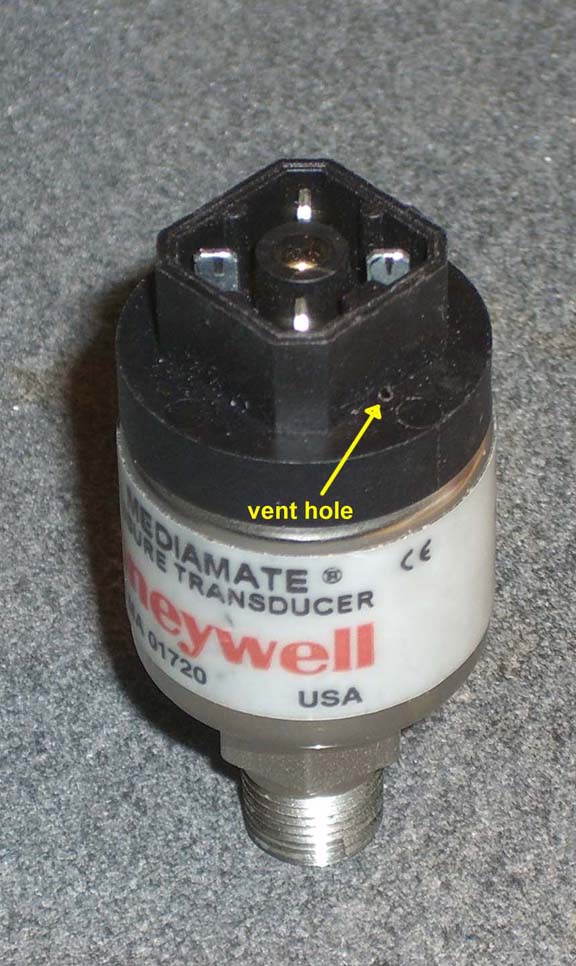
TB20GT Oil Pressure Gauge
The original Socata TB20GT aircraft has two means of indicating engine oil pressure: an oil pressure switch which illuminates a panel lamp when the oil pressure falls below a lower limit, and a continuously reading pressure indicating instrument.
It is a very good system. However, the latter device has a history of poor reliability because it uses an incorrect type of sensor (Honeywell MM200PG1HA) which has a vent hole so that it indicates pressure relative to the atmospheric pressure:

The vent hole allows ingress of humidity which eventually corrodes the electronics (the 4-resistor strain gauge bridge) inside it. The vent hole is a common industry requirement but one needs to ensure that the vent comes out somewhere where the atmosphere is benign - hardly the case under an aircraft engine cowling which can have rain entering it at 150kt! In the sensing industry this failure issue is well known and is sometimes solved by venting the transducer, via a long tube (or even via the centre of its connecting cable) to a remote dry location.
However, ultimately the choice of a vented transducer in this case is based on a mis-understanding of how the engine oil system works: the engine uses a gear pump (constant volume rate, delivery proportional to engine RPM) followed by a spring loaded bypass valve which delivers an oil pressure that is absolute and not relative to ambient air pressure. Therefore, an unvented (absolute) transducer would have been the appropriate type to use. Even if the engine oil pressure was ambient pressure related (which is probably is to some extent, as the crankcase vents to the outside) an absolute reading transducer will introduce only a ~ 7psi error at the TB20 operating ceiling (20,000ft, 500 millibars) which is not significant given the top of the red band is around 130psi.
In 2002, Socata issued a Service Bulletin SB10-129 which claims to fix the corrosion problem by applying heatshrink sleeving over the connector-cable interface. This SB unfortunately misunderstands the problem in two ways: Socata never realised there is the vent hole (which makes sealing the connector pointless), and the Hirchmann connector used in this case contains a sealing o-ring which will seal the cable entry (to IP65) if correctly tightened. Unsuprisingly, this SB has no effect on the problem.
Changing the transducer takes only minutes but unfortunately one cannot legally fit a better transducer. While it is possible via an authorised modification, there is a strong case for leaving the factory installation intact and using the authorised modification process to fit a second totally independent indicator system. One is far more likely to get an instrument malfunction than a real engine problem but what can one do? Disregard a warning of an imminent engine failure, or install a second gauge? On a single engine aircraft, a verified loss of oil pressure is an emergency that requires an immediate landing, preferably at an airport of course... I already have two oil temperature indicators; however the often-repeated line that a bad oil pressure reading not accompanied by a bad oil temperature reading is just an instrument problem is rubbish, in the case of an oil leak well downstream of the oil pump.
A backup oil pressure gauge has been installed on a TB20 aircraft based in the USA. Under FAA rules (Part 43 Appendix A) this is a minor mod which does not need a DER to be involved provided one does it with components that come with approved data, and one can get very nice TSOd parts (indicator and transducer) from UMA. Under EASA, this would most likely be a Major Mod.
The original Socata oil pressure indicating system also has a radio interference problem in that one's own transmission on VHF, particularly on certain frequencies, causes the oil pressure indication to fall to zero! The correlation can be hard to discover, since one is rarely looking at the oil pressure when making a radio call, so the problem can be quite alarming. Socata did eventually (c. 2005) develop a filter kit for this, but basically it is just a standard commercial DB25 connector filter which fits into the DB25 connector at the back of the instrument cluster. This filter from RS is known to work fine.
This page last edited 1st July 2008
Any feedback, reports of dead links, corrections or suggestions much appreciated:
Contact details